Welcome to the Dr. Mom class! I want to give a huge THANK YOU and acknowledge the incredible amount of research and effort that my sweet, smart friend Amanda Uribe did to put this class together. She has graciously offered to let folks share the information, and so it is with her blessing and permission that I am using her posts and graphics. Where applicable, I’m inserting my own experiences and insight, so when you read “I,” you can know it does refer to me, Beverly Jacobson! But a HUGE amount of credit is to Amanda. I’m grateful to call her a friend and a mentor. ❤️
There are 15 topics here, so you may need to break up your learning into bite-sized sessions. We cover everything from vitamins and probiotics to elderberry, magnesium, and more.
Feel free to ask questions. Please know that I am not giving medical advice here, nor am I a medical professional. I'm just sharing research and information the Uribe family as well as we, the Jacobson family, have used for years in order to keep us healthy and well. Please do your own research, speak with your healthcare professional if needed, and make the decisions that are right for your family!
Feel free to ask questions. Please know that I am not giving medical advice here, nor am I a medical professional. I'm just sharing research and information the Uribe family as well as we, the Jacobson family, have used for years in order to keep us healthy and well. Please do your own research, speak with your healthcare professional if needed, and make the decisions that are right for your family!
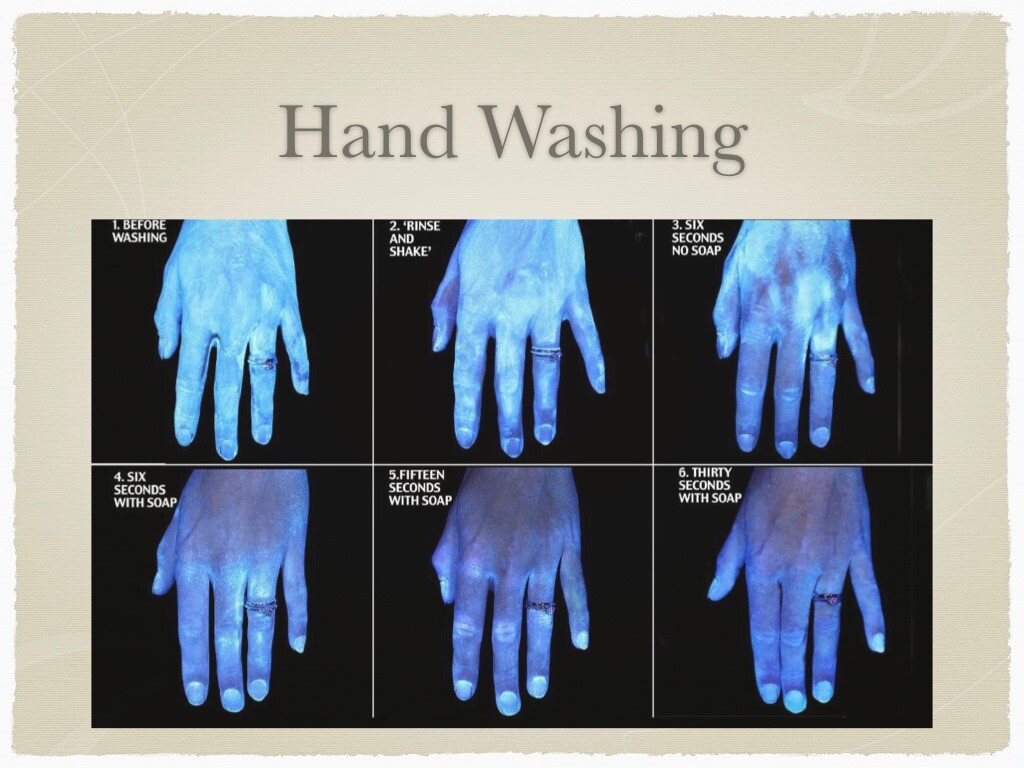 1. HAND WASHING!
1. HAND WASHING!
* hand sanitizer is not a replacement for washing
* viruses can survive sanitizer
* most sanitizer is a chemical carcinogen
Since most sanitizers are antibacterial, they'll sure kill off those nasty bacteria germs that cause illness. But viruses are whole different breed. There is research to prove the efficacy of sanitizer on viruses -- many will not survive a sanitizer with 60% or more of an alcohol based solution. But several will. The biggest downside to current commercially available sanitizers is the chemical content. Most sanitizers contain ingredients that shouldn't be anywhere near the human body. Known carcinogens. Cancer-causers. Hormone disrupters. Reproductive disruptors. Chemically laden soup.
There are two I love:
The first one, Thieves Hand Sanitizer, is Young Living's hand sanitizer. Made with the some of the same Ingredients those historic thieves used during the Black Plague, it is a powerhouse of essential oil goodness in a base of alcohol that can destroy even the toughest health threats.
The second, I made myself with Amanda’s recipe below!
For the gel kind, grab a squeezable bottle and add:
1/3 cup pure Witch Hazel (note, I use a Witch Hazel with alcohol)
2/3 cup Aloe Vera Gel
15-20 drops Thieves essential oil
1-3 capsules of Vitamin E
For the gel kind, grab a squeezable bottle and add:
1/3 cup pure Witch Hazel (note, I use a Witch Hazel with alcohol)
2/3 cup Aloe Vera Gel
15-20 drops Thieves essential oil
1-3 capsules of Vitamin E
Feel comfortable with alcohol in a hand sanitizer and need it to kill super cooties? Research shows for full effectiveness, sanitizer HAS to have alcohol -- according to science 60%! The witch hazel we buy does have 14% but to bump it up, Amanda adds Everclear to the mix in a 3/1 alcohol to H2O ratio. (Use vodka, NOT isopropyl alcohol!)
Want the spray kind? Instead of aloe, add water! Here's a video on my FB page An Essential Harvest showing how to make the spray kind.
Nothing, NOTHING, will prevent coughs and colds more than good hand washing practices!
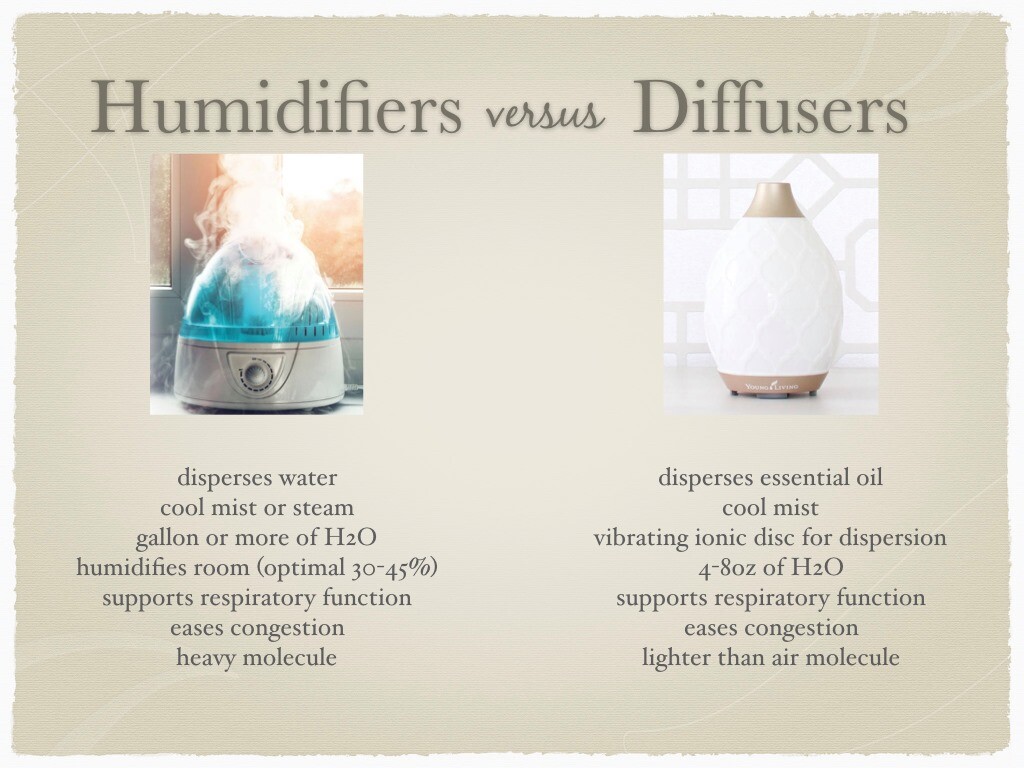
2. HUMIDIFIERS VS. DIFFUSERS
Which one do you need? Research shows BOTH! Let's talk about why.
Humidifiers:
The average house -- unless you live in one of those few truly wet climates in the USA -- is dry. Optimal humidity should be somewhere between 30-45%. If it drops beneath 30%, it's too low. Above 50%, it's too high. Why? A few reasons! First, various germs and bacteria either thrive in a very dry environment or a very moist environment.
The average house -- unless you live in one of those few truly wet climates in the USA -- is dry. Optimal humidity should be somewhere between 30-45%. If it drops beneath 30%, it's too low. Above 50%, it's too high. Why? A few reasons! First, various germs and bacteria either thrive in a very dry environment or a very moist environment.
Studies indicate various viruses thrive at low humidity levels. Those "winter illnesses" we've all come to know season after season are exacerbated by our indoor, dry, stale environment. Mucus membranes that dry out are simply more susceptible to viruses and bacteria invasion.
Fungi, mites, molds, and mildew will flourish in high humidity. Mite populations, for example, will explode around 80% humidity, but decline rapidly below 50% humidity. Most fungi need humidity around 60% or above to thrive.
If you want to keep them at bay, stay in that optimal zone throughout the year -- which can be tricky in the winter if you run a heater as those will dry out your house pretty quick! In those moist areas like Florida, check into a dehumidifier!
Humidifiers work by either releasing cool or warm mist in the air. Neither is truly "better" than the other. Most people have the simple portable units that can be refilled and placed in any room. Whole house humidifiers are available, too. It works by adding a fine mist to your air system, circulating it throughout the house. You can also get a hygrometer. They are cheap and effective at monitoring your indoor environment.
I've been asked repeatedly over the years if I put essential oils in my humidifier. I don't and sure don't recommend you do, either! See, water is a large molecule. When it exits a humidifier, it doesn't really rise and circulate. It flows up briefly because of your device, but then it falls to the floor and works to humidify as it evaporates.
Essential oils on the other hand, are so small, they are measured in Daltons (lighter than air particles like smog or city pollution but healthy). They rise up in the air and circulate throughout rooms. Putting them in the humidifier will do little more than anchor them to your carpet with the water, slowly evaporating over time.
Your essential oil diffuser is a MUST have for your oils! Make sure if it's not a diffuser from Young Living, that it has a stainless steel ionizing tablet in the bottom of it. The little coin acts as a dispersing agent vibrating at an ultrasonic frequency of 1.7 million waves per second, infusing the water with essential oils and creating a fine particle mist which will be incorporated into the air around you and circulate with your central air system, fans, and even your movement! Note: if you have Feather the Owl diffuser, you won't see this plate. This cute little guy uses a newer structural design and all you'll see is a hollow core in the center.
We've got both going pretty much all fall and winter and find them to be a necessity for our health and wellness. If you don't have a humidifier, remember you can just set on a tea kettle, run the shower, or run through your house with a spray bottle misting everything like a fairy. 😂
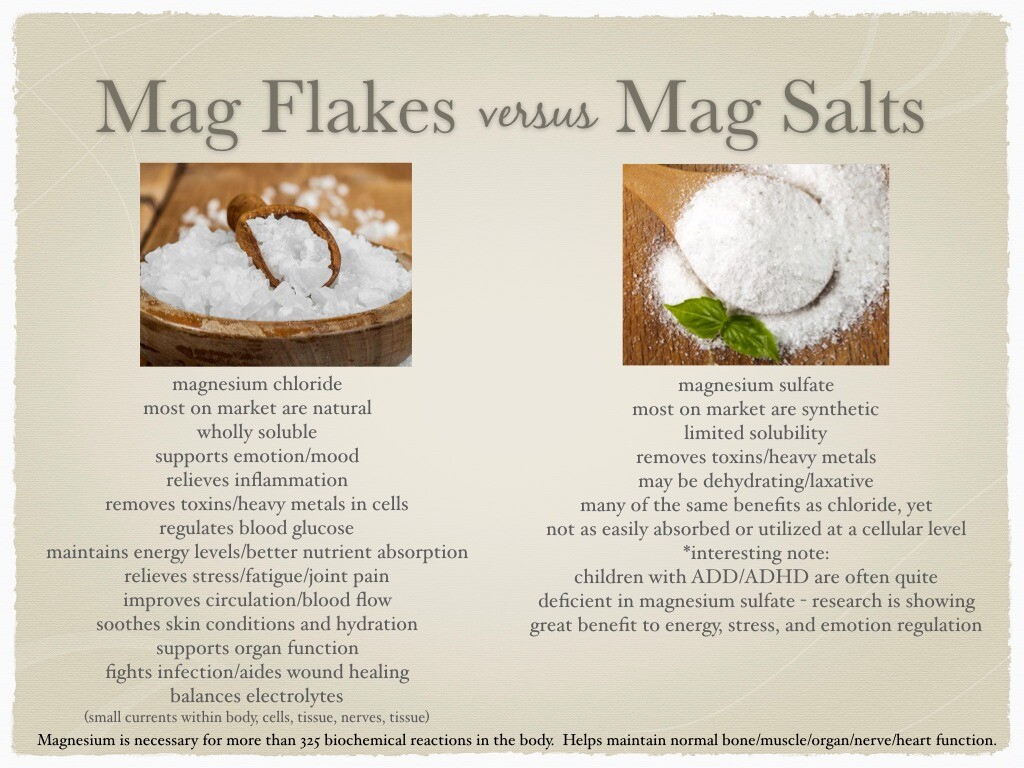
3. MAGNESIUM
Did you know they're not the same thing? There's a common misconception that one is the fine ground version and the other the pretty flake version -- so, the thought leads to the question, "Why would I pay more for pretty flakes?!" and most will go on to buy epsom salts. Confession from Beverly: This Dr. Mom class is the first time I’ve heard of the flakes!! I’m constantly learning, too!
Magnesium Flakes = Magnesium Chloride
Magnesium Salts = Magnesium Sulfate
Some of the known benefits of magnesium FLAKES:
• improves mood and reduces stress
• increases ATP in cells =energy
• boosts immune system
• supports cognition and memory
• antimicrobial and antiseptic
• supports endocrine system
• supports hormones and monthly symptoms
• supports joint flexibility
• raises DHEA in the body
• balances calcium and magnesium in cells
• improves skin health
• supports healthy cholesterol
• supports antioxidant processes in the body
• keeps cells flexible and healthy
• eases sore muscles
• eases tension and headaches
• supports relief of pain
• aides in dental health
• supports cardiovascular health
• replenishes MG levels
• supports cell functions
• calms nerves
• replenishes soft tissues in the body
• supports organ health
• critical for cell metabolism
• supports muscle and nerve function
• stabilizes heart rhythm
• supports healthy blood sugar levels
• supports healthy blood pressure
• helps maintain structural integrity of DNA
Source: Transdermal Magnesium Therapy (2007)
Magnesium is CRITICAL for cells, bone, muscle, and organ health! Without magnesium, many nutrients and substances your body relies on wouldn't be properly utilized by your body. Just some of them: calcium, potassium, phosphorus, zinc, copper, sodium, lead, cadmium, hydrochloric acid, acetylcholine, and nitric oxide. In fact, magnesium is required for over 300 magnesium dependent enzymes, for cellular homeostasis, and the activation of vitamin B (thiamin).
We do get this mineral from water and foods we eat!
• Fruits
• Veggies
• Nuts
• Legumes
• Seeds
• Whole Grains
• Some Fatty Fish
• Dark Chocolate (mmmmm)
The issues is, our soil mineral content is severely depleted due to over-farming and poor land management (pesticides and chemicals), so most people get about half of the daily recommendation of magnesium: 350-400mg. Current research is showing most people are extremely deficient in this mineral. The largest issue we see with this deficiency is our overload of calcium intake. I'm sure you remember the "drink milk" campaign? Everyone increased milk consumption, schools only served milk cartons, all dairy products became superstars overnight! The problem here is our intake of calcium is extreme, yet calcium cannot be properly assimilated to bone unless magnesium is present. Current research now suggests a one to one ratio of magnesium to calcium.
So what happens if magnesium is not present for calcium? Pretty horrible things, actually. Magnesium is necessary for calcium to enter the bone and bind. Without it, calcium develops as little crystals on the surface of the bone and in soft tissues of the body. This creates extreme pain over time, joint, muscle, and circulation aches. Described by sufferers as "walking on glass, tingling, burning, deep aches or throbbing," this issue takes months or years to resolve once present. Practitioners and mainstream advertising have been overprescribing calcium for quite some time. Brittle bones and osteoporosis are fairly common, yet no one is hosting a magnesium campaign despite the science revealing time and again, it is vital to health and the most common depleted mineral in the body.
So, let's look at Magnesium Sulfate. Inferior? No, not really, still beneficial to the body, but perhaps not as widely needed and essential as Magnesium Chloride. Science is showing us, though, kids with ADD/ADHD are repeatedly seen to be deficient in this one -- and the uptake of mag sulfate is resulting in kids with more calm. As more studies are done on this one, I can't wait to learn more!
Lastly, what about the oil? Magnesium oil is super great, but the research is showing flakes are better! More concentrated and better absorbed transdermally in a WARM bath tub. Remember, hot baths are for excretion, warm baths are for infusion. Note, you can start with a hot bath... just stay long enough to get to warm -- and know you will have experienced both methods so drink a TON OF WATER!
Want to know the country with the highest intake of magnesium chloride... and not so coincidentally, one of the healthiest in the world? Japan. Their main source of magnesium is a seafood diet with the staple being nigari infused soups, tofus, and foods, seaweed and spirulina as a staple dish ingredient, and minimal calcium derived from vegetables rather than dairy. Food for thought!
Want to learn more? Check out this book: Transdermal Magnesium Therapy, Mark Sircus
Magnesium Flakes = Magnesium Chloride
Magnesium Salts = Magnesium Sulfate
Some of the known benefits of magnesium FLAKES:
• improves mood and reduces stress
• increases ATP in cells =energy
• boosts immune system
• supports cognition and memory
• antimicrobial and antiseptic
• supports endocrine system
• supports hormones and monthly symptoms
• supports joint flexibility
• raises DHEA in the body
• balances calcium and magnesium in cells
• improves skin health
• supports healthy cholesterol
• supports antioxidant processes in the body
• keeps cells flexible and healthy
• eases sore muscles
• eases tension and headaches
• supports relief of pain
• aides in dental health
• supports cardiovascular health
• replenishes MG levels
• supports cell functions
• calms nerves
• replenishes soft tissues in the body
• supports organ health
• critical for cell metabolism
• supports muscle and nerve function
• stabilizes heart rhythm
• supports healthy blood sugar levels
• supports healthy blood pressure
• helps maintain structural integrity of DNA
Source: Transdermal Magnesium Therapy (2007)
Magnesium is CRITICAL for cells, bone, muscle, and organ health! Without magnesium, many nutrients and substances your body relies on wouldn't be properly utilized by your body. Just some of them: calcium, potassium, phosphorus, zinc, copper, sodium, lead, cadmium, hydrochloric acid, acetylcholine, and nitric oxide. In fact, magnesium is required for over 300 magnesium dependent enzymes, for cellular homeostasis, and the activation of vitamin B (thiamin).
We do get this mineral from water and foods we eat!
• Fruits
• Veggies
• Nuts
• Legumes
• Seeds
• Whole Grains
• Some Fatty Fish
• Dark Chocolate (mmmmm)
The issues is, our soil mineral content is severely depleted due to over-farming and poor land management (pesticides and chemicals), so most people get about half of the daily recommendation of magnesium: 350-400mg. Current research is showing most people are extremely deficient in this mineral. The largest issue we see with this deficiency is our overload of calcium intake. I'm sure you remember the "drink milk" campaign? Everyone increased milk consumption, schools only served milk cartons, all dairy products became superstars overnight! The problem here is our intake of calcium is extreme, yet calcium cannot be properly assimilated to bone unless magnesium is present. Current research now suggests a one to one ratio of magnesium to calcium.
So what happens if magnesium is not present for calcium? Pretty horrible things, actually. Magnesium is necessary for calcium to enter the bone and bind. Without it, calcium develops as little crystals on the surface of the bone and in soft tissues of the body. This creates extreme pain over time, joint, muscle, and circulation aches. Described by sufferers as "walking on glass, tingling, burning, deep aches or throbbing," this issue takes months or years to resolve once present. Practitioners and mainstream advertising have been overprescribing calcium for quite some time. Brittle bones and osteoporosis are fairly common, yet no one is hosting a magnesium campaign despite the science revealing time and again, it is vital to health and the most common depleted mineral in the body.
So, let's look at Magnesium Sulfate. Inferior? No, not really, still beneficial to the body, but perhaps not as widely needed and essential as Magnesium Chloride. Science is showing us, though, kids with ADD/ADHD are repeatedly seen to be deficient in this one -- and the uptake of mag sulfate is resulting in kids with more calm. As more studies are done on this one, I can't wait to learn more!
Lastly, what about the oil? Magnesium oil is super great, but the research is showing flakes are better! More concentrated and better absorbed transdermally in a WARM bath tub. Remember, hot baths are for excretion, warm baths are for infusion. Note, you can start with a hot bath... just stay long enough to get to warm -- and know you will have experienced both methods so drink a TON OF WATER!
Want to know the country with the highest intake of magnesium chloride... and not so coincidentally, one of the healthiest in the world? Japan. Their main source of magnesium is a seafood diet with the staple being nigari infused soups, tofus, and foods, seaweed and spirulina as a staple dish ingredient, and minimal calcium derived from vegetables rather than dairy. Food for thought!
Want to learn more? Check out this book: Transdermal Magnesium Therapy, Mark Sircus
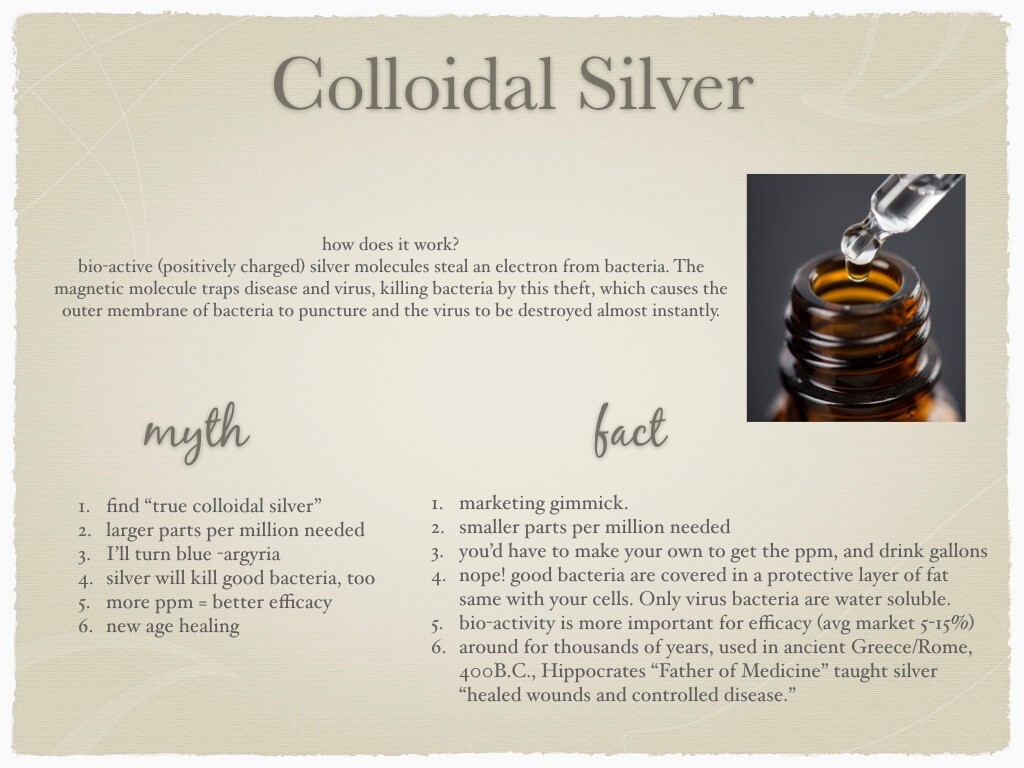
4. COLLOIDAL SILVER
(Note from Beverly: this is something I personally have not incorporated into our health care routines, simply because prior to now I really did not have good knowledge about it!)
This one has been around for centuries! The Greeks and Romans both used colloidal silver for everything from cleanliness and health care to wound care. Ancient Greeks drank from silver vessels for purification of water. Pioneers of the old west would put silver dollars in their water casks and milk jugs to delay spoilage and prevent dysentery, colds, and viruses. Settlers in the Australian outback were known to add silverware in their water tanks to prevent bacteria growth.
By the turn of the 20th century medical silver compounds were in massive wide spread use. Mid-century, we used hundreds of different silver compounds, marketing them, prescribing them, and using them to treat practically every infectious disease imaginable. Research from the 1970's revealed silver has power against 22 bacterial species -- 643 isolates. It is used in hospitals for everything from bandages and needles to disinfectants and cleaners. Wound and burn care have seen huge benefits in healing when silver spray, gel, liquid, or bandages have been added to care protocol.
One of the biggest fears is, "I'm afraid I'll turn blue (argyria) -- from too much silver." While people have, in fact, turned blue from too much silver ingestion, it is super rare and would require you to drink gallons highly concentrated silver water. The most notable cases all admitted to creating their own silver water of highly concentrated silver particles, and drinking it in place of water consumption with up to a dozen glasses of silver water per day for months on end. Historically, the blue blood aristocracy did in fact have a bluish tint to them. But once again, more so due to little regulation or prudence in its use. Remember, even water can kill you in excess.
Smaller particles are needed on this one. Smaller covers more surface area. Positive silver ions are also needed. See, the way silver works is that this charge will lead it to steal the electron of a virus cell. Viruses, unlike your cells, are water soluble. When this electron is stolen, the virus cell ruptures and dies. A solution of 10-250 ppm of Silver is more than adequate if the silver is positively charged. More often that not, what we see is large particles with huge numbers in the parts per million, but no positive charge whatsoever.
I've also heard a marketing term lately, "structured silver" and think it's worth mentioning here. Not that there is anything wrong with purchasing a brand touting structured silver, but more often that not, it is a marketing term. Water is structured after all. What does this mean for the silver? Any silver solution, including the dozens that were available in the 19th century, is structured in some way: ratio of silver to water, size of silver particles, positive charge ratio, compounds of the silver solution used, etc. In the end, what matters are 3 things:
• high positive charge
• smallest particles possible
• high quality source of silver
This pubmed.gov article is one of Amanda’s favorites on the subject. Be sure to check out Tables 1-3 (and scroll down them!).
Can you name the YL product with colloidal silver as an ingredient? It's one of my favorite!
This one has been around for centuries! The Greeks and Romans both used colloidal silver for everything from cleanliness and health care to wound care. Ancient Greeks drank from silver vessels for purification of water. Pioneers of the old west would put silver dollars in their water casks and milk jugs to delay spoilage and prevent dysentery, colds, and viruses. Settlers in the Australian outback were known to add silverware in their water tanks to prevent bacteria growth.
By the turn of the 20th century medical silver compounds were in massive wide spread use. Mid-century, we used hundreds of different silver compounds, marketing them, prescribing them, and using them to treat practically every infectious disease imaginable. Research from the 1970's revealed silver has power against 22 bacterial species -- 643 isolates. It is used in hospitals for everything from bandages and needles to disinfectants and cleaners. Wound and burn care have seen huge benefits in healing when silver spray, gel, liquid, or bandages have been added to care protocol.
One of the biggest fears is, "I'm afraid I'll turn blue (argyria) -- from too much silver." While people have, in fact, turned blue from too much silver ingestion, it is super rare and would require you to drink gallons highly concentrated silver water. The most notable cases all admitted to creating their own silver water of highly concentrated silver particles, and drinking it in place of water consumption with up to a dozen glasses of silver water per day for months on end. Historically, the blue blood aristocracy did in fact have a bluish tint to them. But once again, more so due to little regulation or prudence in its use. Remember, even water can kill you in excess.
Smaller particles are needed on this one. Smaller covers more surface area. Positive silver ions are also needed. See, the way silver works is that this charge will lead it to steal the electron of a virus cell. Viruses, unlike your cells, are water soluble. When this electron is stolen, the virus cell ruptures and dies. A solution of 10-250 ppm of Silver is more than adequate if the silver is positively charged. More often that not, what we see is large particles with huge numbers in the parts per million, but no positive charge whatsoever.
I've also heard a marketing term lately, "structured silver" and think it's worth mentioning here. Not that there is anything wrong with purchasing a brand touting structured silver, but more often that not, it is a marketing term. Water is structured after all. What does this mean for the silver? Any silver solution, including the dozens that were available in the 19th century, is structured in some way: ratio of silver to water, size of silver particles, positive charge ratio, compounds of the silver solution used, etc. In the end, what matters are 3 things:
• high positive charge
• smallest particles possible
• high quality source of silver
This pubmed.gov article is one of Amanda’s favorites on the subject. Be sure to check out Tables 1-3 (and scroll down them!).
Can you name the YL product with colloidal silver as an ingredient? It's one of my favorite!
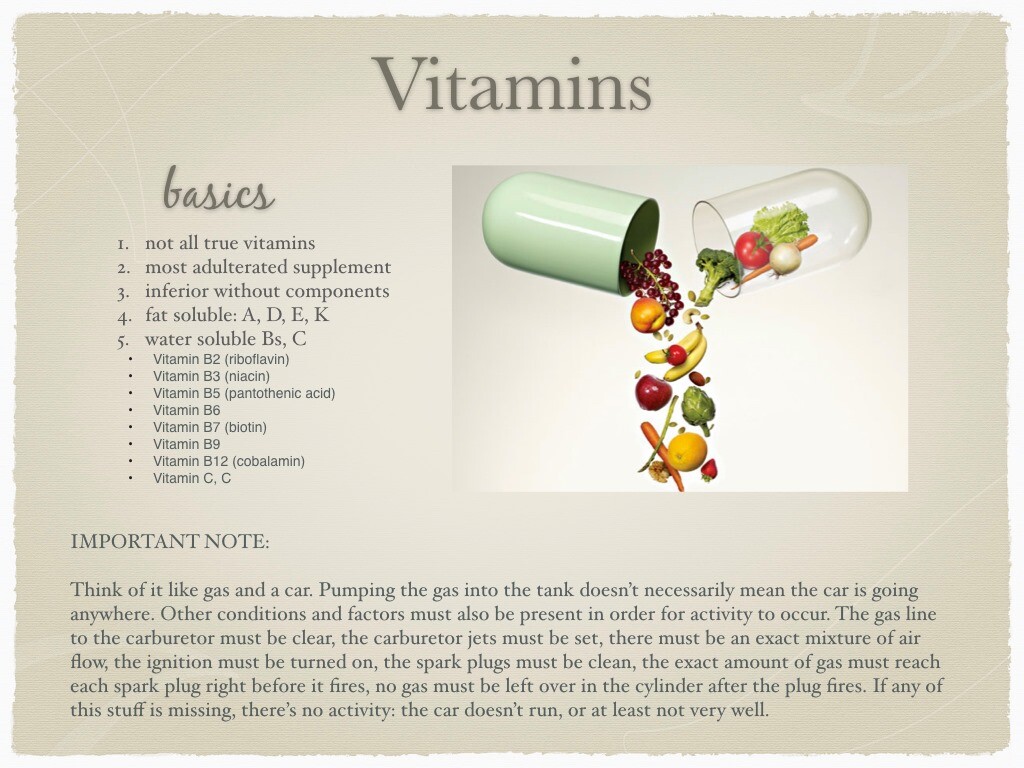
5. VITAMINS
These are just crazy important, friends! I know there's been some media attention in this the last several years. Both positive and negative. We're going to explore the truth behind everything and figure out what we need to maintain our healthy lifestyles! First, let's discuss the difference between fat soluble and water soluble vitamins.
Fat-soluble Vitamins: A, D, E, K
• dissolved by fat or oil
• when unused stored in liver and fat tissue
• Fat-soluble vitamins are absorbed through the intestinal tract with the help of fats, or lipids
Water-soluble Vitamins: B's & C
• dissolved by water
• eliminated as urine when not needed
• this type of vitamin does not store in the body
Most vitamins on the market today are NOT vitamins. They are fully synthetic or lab created from components of original food products paired with synthetic counterparts. Vitamins are the most adulterated supplement on the market today! Eeeeek! This adulteration and synthesized lab creation has created a recipe for health disaster. While professionals claim far and wide these man-made vitamins are identified by the body in the same manner as their nature made counterparts, nothing could be further from the truth. Current research indicates your body needs—desperately needs—a whole food source vitamin.
Aside from the obvious, man-made versus nature-made debate, here's the thing. Each whole food source vitamin your body uptakes contains a plethora of minerals and nutrients to aid in absorption, utilization, and efficacy of the vitamin being assimilated. If those minerals are not present in the vitamin, where do you imagine they'll come from? By depleting the body, of course! The result is a body suffering from malnutrition regardless of the amount of food consumed.
For example, do you remember when I told you in a previous point that in order for calcium to enter the bones properly, magnesium MUST be present? Without it, not only will calcium fail to be as beneficial, but it will actually do harm in the form of crystalized deposits in tissues and on the surface of bones where it simply shouldn't be. The same holds true for vitamins. Without those all important minerals and nutrient counterparts, vitamins are inefficient at best, toxic at worst.
Don't worry. We're going in depth into this one over the next several points for better understanding!
Fat-soluble Vitamins: A, D, E, K
• dissolved by fat or oil
• when unused stored in liver and fat tissue
• Fat-soluble vitamins are absorbed through the intestinal tract with the help of fats, or lipids
Water-soluble Vitamins: B's & C
• dissolved by water
• eliminated as urine when not needed
• this type of vitamin does not store in the body
Most vitamins on the market today are NOT vitamins. They are fully synthetic or lab created from components of original food products paired with synthetic counterparts. Vitamins are the most adulterated supplement on the market today! Eeeeek! This adulteration and synthesized lab creation has created a recipe for health disaster. While professionals claim far and wide these man-made vitamins are identified by the body in the same manner as their nature made counterparts, nothing could be further from the truth. Current research indicates your body needs—desperately needs—a whole food source vitamin.
Aside from the obvious, man-made versus nature-made debate, here's the thing. Each whole food source vitamin your body uptakes contains a plethora of minerals and nutrients to aid in absorption, utilization, and efficacy of the vitamin being assimilated. If those minerals are not present in the vitamin, where do you imagine they'll come from? By depleting the body, of course! The result is a body suffering from malnutrition regardless of the amount of food consumed.
For example, do you remember when I told you in a previous point that in order for calcium to enter the bones properly, magnesium MUST be present? Without it, not only will calcium fail to be as beneficial, but it will actually do harm in the form of crystalized deposits in tissues and on the surface of bones where it simply shouldn't be. The same holds true for vitamins. Without those all important minerals and nutrient counterparts, vitamins are inefficient at best, toxic at worst.
Don't worry. We're going in depth into this one over the next several points for better understanding!
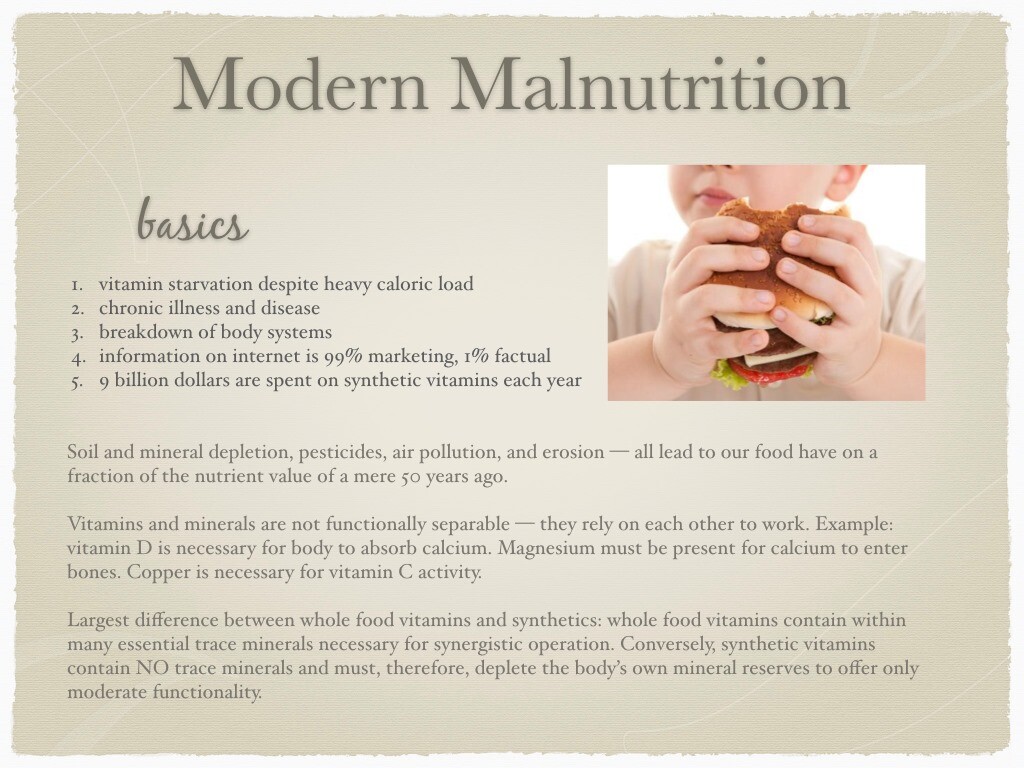
6. MODERN MALNUTRITION
In today's world, it's often hard to imagine chronic malnutrition in the general population. After all, food is everywhere—especially fast food. The grocery store shelves are bursting with every sort imaginable, right? Truthfully, our ancestors, with fewer food choices and often lack of access to three meals a day still had better nutrition than we have today. They ate true food. We eat food-like products. Today's food is more like a science project than a food project and the result is malnutrition. Satiation of hunger, but little else.
Chronic disease and illness is at an all time high. Most diseases we hear about repeatedly are symptoms of our chemically saturated and vitamin-absent culinary buffet. Eating the garden has become a thing of the past, and those who still strive to do so, find the garden depleted of enzymes and minerals, filled with pesticides and toxins, and generally lacking the core necessities to offer pure value.
To compensate, food manufacturers inundate us with hollow claims of fortified, natural or enriched foods, each touting the nutrition of their product, vitamin, or supplement. Don't be fooled! It's all marketing. There is no such thing as a "natural dorito" despite the claim on the package. With 2/3 of all corn now GMO and specifically bred with known neurotoxins and compounds to eliminate pests, even the most simple of ingredients on a package could mean nothing. We need to look further to see where those ingredients came from originally.
Chronic disease and illness is at an all time high. Most diseases we hear about repeatedly are symptoms of our chemically saturated and vitamin-absent culinary buffet. Eating the garden has become a thing of the past, and those who still strive to do so, find the garden depleted of enzymes and minerals, filled with pesticides and toxins, and generally lacking the core necessities to offer pure value.
To compensate, food manufacturers inundate us with hollow claims of fortified, natural or enriched foods, each touting the nutrition of their product, vitamin, or supplement. Don't be fooled! It's all marketing. There is no such thing as a "natural dorito" despite the claim on the package. With 2/3 of all corn now GMO and specifically bred with known neurotoxins and compounds to eliminate pests, even the most simple of ingredients on a package could mean nothing. We need to look further to see where those ingredients came from originally.
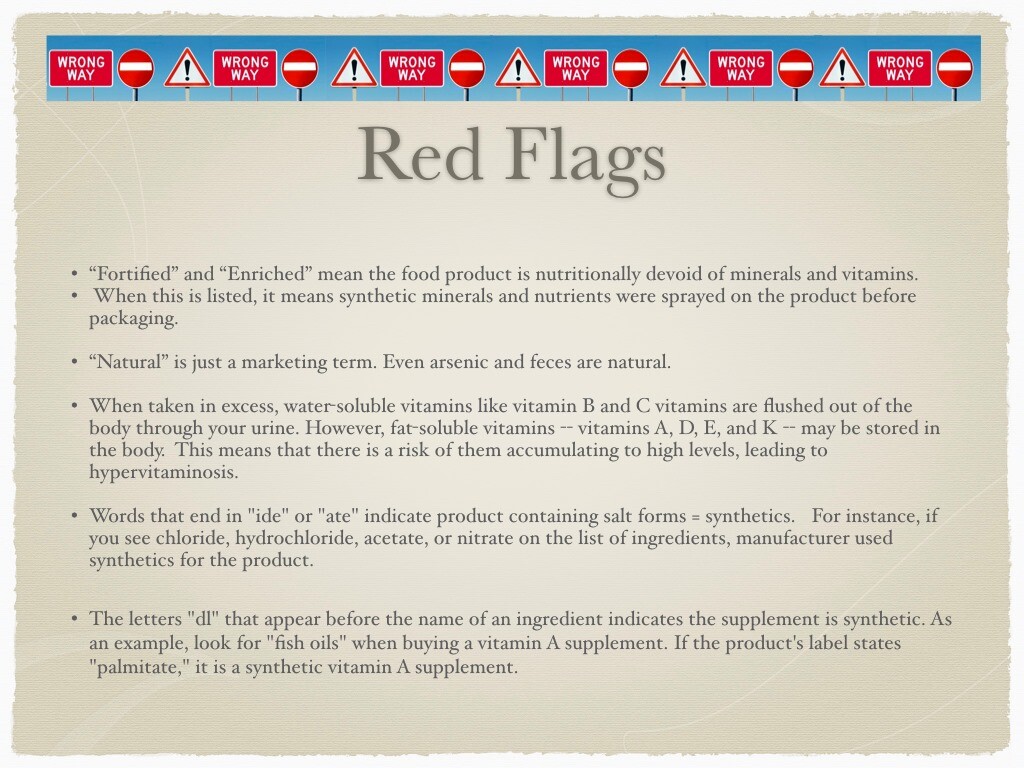
7. RED FLAGS TO WATCH OUT FOR
Those marketing techniques we mentioned in point #6 confuse most Americans. When asked, many will state they purchase a certain cereal or cracker because the box states "fortified with essential nutrients" or "enriched with Vitamin D," but they fail to understand what it truly means. As a parent, we want to give our kids the very best, and we know they're picky eaters, too, so we think, "I should snag that cereal! Even with all of the marshmallows and fun colors, it does say they enriched it with a full serving of minerals and vitamins!"
Does it scare you to learn that when those words are listed, it means the final product before packaging was sprayed much like crop dusting with a host of synthetic nutrients? It scared the daylights out of me! Even more shocking is most are sprayed with another can of synthetic preservatives so it can sit on the shelf for six months to a year or more. Anyone else gagging now? What about the ones that say, "naturally enriched or fortified" or for that matter "naturally sourced or naturally colored"? Sadly, natural is also a marketing term. Even arsenic, lead, and petroleum are natural and organic. We wouldn't eat those, right? Oh, but we do! They've been found in major everyday food staples on shelves the world over.
It's all about marketing. We've just become focused lately on health and food from natural sources, so marketing teams the world over are creating beautiful graphics, catchy slogans, and blasting the words “natural,” “nature made,” or “naturally” all over the packaging. Once again, don't be fooled! So...how are we to know if the ingredient is synthetic or not? Well, honestly, there is no fail safe way to do so. I know, not very comforting. But there are some key words and letters to look for that are sure indicators.
• Words that end in "ide" or "ate" indicate product containing salt forms; these are most often synthetics.
• The letters "dl" that appear before the name of an ingredient indicates the supplement is synthetic.
Examples:
synthetic vitamin A: retinyl palmitate
synthetic vitamin E: dl-alpha-tocopherol
Look for the whole food source in the ingredients. If you don't see actual fruits, veggies, fish, or plant life listed there, RUN! Now…be aware that what you are (or should be) doing is looking for the name on the vitamin or supplement bottle and then researching further. The vitamins CAN sometimes come from a whole food source. But, for example, if the label just states “riboflavin” or “biotin” without listing the source, DO MORE RESEARCH. For example, whole food sources of riboflavin are:
beef liver
yogurt
milk
spinach
almonds
eggs
lamb
quinoa
lentils
mushrooms
tahini
wild salmon
But synthetic riboflavin is made with acetic acid and nitrogen or using genetically modified bacteria and fermentation. It will simply be listed as "riboflavin" without the ingredients showing whole food source. Same with ascorbic acid. Later, in our vitamin C post, we will see that ascorbic acid is often derived from a compound in nature, but then modified in a lab. But it CAN be derived from a whole food source with minimal processing. You’ll need to research the product further to determine if it falls into a synthetic or whole food derivative.
Again, this is a post to start your questions and research. Labels that list vitamin names and ONLY those names—without listing the whole food source it was derived from—are quite often synthetic. And listen…if you ARE NOT SURE…I’m just saying…maybe it’s time to switch to Young Living vitamins and supplements! This is what we have done, because we KNOW beyond the shadow of a doubt that we are absolutely using the best products available. (Additionally, YL vitamins and supplements contain essential oils to enhance their bioavailability, allowing our bodies to absorb even more of the needed components!)
Does it scare you to learn that when those words are listed, it means the final product before packaging was sprayed much like crop dusting with a host of synthetic nutrients? It scared the daylights out of me! Even more shocking is most are sprayed with another can of synthetic preservatives so it can sit on the shelf for six months to a year or more. Anyone else gagging now? What about the ones that say, "naturally enriched or fortified" or for that matter "naturally sourced or naturally colored"? Sadly, natural is also a marketing term. Even arsenic, lead, and petroleum are natural and organic. We wouldn't eat those, right? Oh, but we do! They've been found in major everyday food staples on shelves the world over.
It's all about marketing. We've just become focused lately on health and food from natural sources, so marketing teams the world over are creating beautiful graphics, catchy slogans, and blasting the words “natural,” “nature made,” or “naturally” all over the packaging. Once again, don't be fooled! So...how are we to know if the ingredient is synthetic or not? Well, honestly, there is no fail safe way to do so. I know, not very comforting. But there are some key words and letters to look for that are sure indicators.
• Words that end in "ide" or "ate" indicate product containing salt forms; these are most often synthetics.
• The letters "dl" that appear before the name of an ingredient indicates the supplement is synthetic.
Examples:
synthetic vitamin A: retinyl palmitate
synthetic vitamin E: dl-alpha-tocopherol
Look for the whole food source in the ingredients. If you don't see actual fruits, veggies, fish, or plant life listed there, RUN! Now…be aware that what you are (or should be) doing is looking for the name on the vitamin or supplement bottle and then researching further. The vitamins CAN sometimes come from a whole food source. But, for example, if the label just states “riboflavin” or “biotin” without listing the source, DO MORE RESEARCH. For example, whole food sources of riboflavin are:
beef liver
yogurt
milk
spinach
almonds
eggs
lamb
quinoa
lentils
mushrooms
tahini
wild salmon
But synthetic riboflavin is made with acetic acid and nitrogen or using genetically modified bacteria and fermentation. It will simply be listed as "riboflavin" without the ingredients showing whole food source. Same with ascorbic acid. Later, in our vitamin C post, we will see that ascorbic acid is often derived from a compound in nature, but then modified in a lab. But it CAN be derived from a whole food source with minimal processing. You’ll need to research the product further to determine if it falls into a synthetic or whole food derivative.
Again, this is a post to start your questions and research. Labels that list vitamin names and ONLY those names—without listing the whole food source it was derived from—are quite often synthetic. And listen…if you ARE NOT SURE…I’m just saying…maybe it’s time to switch to Young Living vitamins and supplements! This is what we have done, because we KNOW beyond the shadow of a doubt that we are absolutely using the best products available. (Additionally, YL vitamins and supplements contain essential oils to enhance their bioavailability, allowing our bodies to absorb even more of the needed components!)
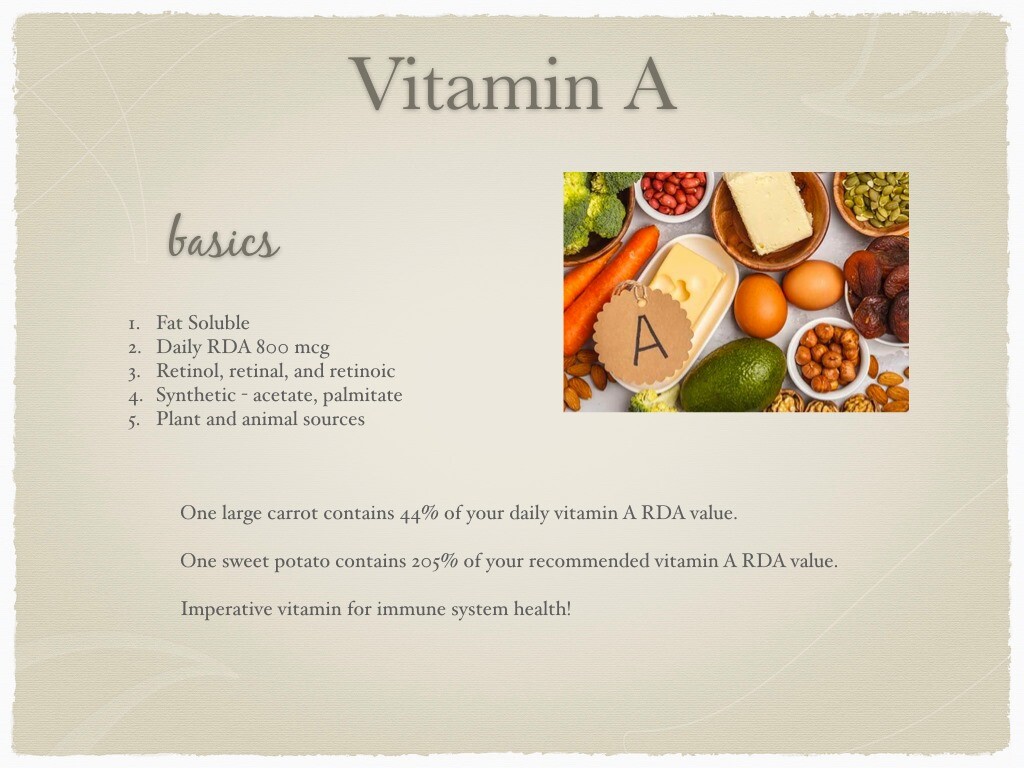 8. VITAMIN A
8. VITAMIN ANot a single vitamin, but rather a collection of compounds known as retinoids that specifically support skin, vision, and immune system function, Vitamin A comes from both plant and animal sources. In plants, the antioxidant beta-carotene is converted to A. In animal sources, vitamin A, or retinols, are ready to use and need no conversion.
Animal sources:
• fish liver oil
• beef liver
• cheese, milk, dairy products
Plant sources:
• sweet potato
• kale, spinach, and other green, leafy vegetables
• carrots
• broccoli
• cantaloupe and other orange fruits
• black-eyed peas
Too much of this one can store in body fat long term and create toxicity. That being said, these situations typically result from supplementation or medication, rather than garden eating.
Symptoms of an overdose include:
• headaches
• fatigue
• nausea
• dizziness
Here is one of many available studies on vitamin A research:
SYNTHETIC: retinyl palmitate or retinyl acetate, made from combining fish or palm oil with beta-ionone. Palm oil is derived from deforestation of rainforests. Beta-ionone is derived from citrus, acetone, and calcium oxide.
Animal sources:
• fish liver oil
• beef liver
• cheese, milk, dairy products
Plant sources:
• sweet potato
• kale, spinach, and other green, leafy vegetables
• carrots
• broccoli
• cantaloupe and other orange fruits
• black-eyed peas
Too much of this one can store in body fat long term and create toxicity. That being said, these situations typically result from supplementation or medication, rather than garden eating.
Symptoms of an overdose include:
• headaches
• fatigue
• nausea
• dizziness
Here is one of many available studies on vitamin A research:
SYNTHETIC: retinyl palmitate or retinyl acetate, made from combining fish or palm oil with beta-ionone. Palm oil is derived from deforestation of rainforests. Beta-ionone is derived from citrus, acetone, and calcium oxide.
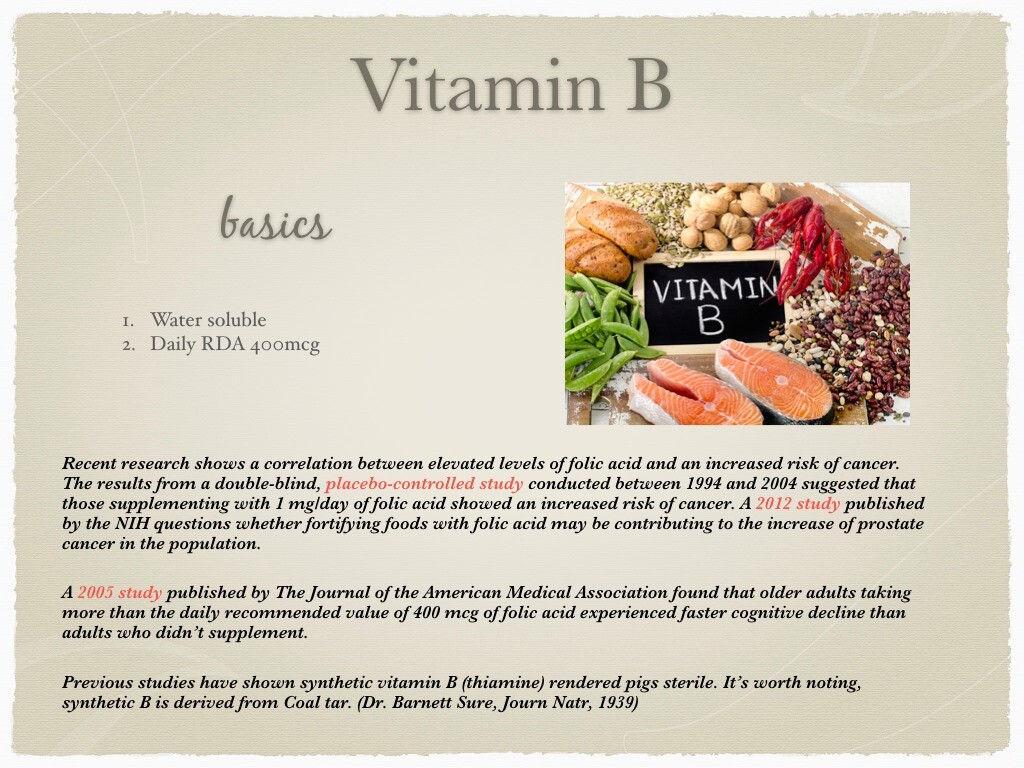 9. VITAMIN B
9. VITAMIN BThis one comprises many forms of B, so stick with me while we go through the list! Vitamin B is water-soluble, derived from both plant and animal sources.
Vitamin B1 – Thiamin, bound to phosphate. Helps cells change carbohydrates into energy. Digestion releases the thiamin using specialized enzymes that target phosphate.
Synthetic: Thiamine mononitrate or thiamine hydrochloride is made from coal tar, ammonia, acetone, and hydrochloric acid. Lacking crucial phosphate.
Vitamin B2 – Riboflavin, used by the body in many important enzyme functions.
Synthetic: made with acetic acid and nitrogen or using genetically modified bacteria and fermentation.
Vitamin B3 – Niacinamide or nicotinamide called niacin. Supports healthy cholesterol and cardiovascular health.
Synthetic: Nicotinic acid is created using coal tar, ammonia, acids, 3-cyanopyridine, and formaldehyde.
Vitamin B5 – Pantothenate. Supports metabolism, healthy skin, hair, and eyes.
Synthetic: Pantothenic acid involves isobutyraldehyde and formaldehyde to form a calcium or sodium salt. The alcohol derivative, panthenol, is sometimes used as it is more stable and lasts longer on store shelves.
Vitamin B6 – Like B1, pyridoxine is bound with phosphate in plants to make pyridoxal-phosphate. Benefits cardiovascular system, muscular function, digestion, and a bunch of other energy and transmitter processes in the body.
Synthetic: Pyridoxine hydrochloride comes from petroleum ester, hydrochloric acid, and formaldehyde - has been shown to actually inhibit the action of natural B6 in the body.
Vitamin B7 – Biotin is involved in cell growth, fat production, and metabolism.
Synthetic: produced using fumaric acid.
Vitamin B9 – Very important in the creation and repair of DNA.
Synthetic: Folic acid doesn’t exist in natural foods, is crystalline, and is not easily absorbed despite the large amounts that are added to vitamins and supplements. It comes from petroleum derivatives, acids, and acetylene.
Vitamin B12 – Cobalamin B12 is only created by micro-organisms like the bacteria that grow in soil and our intestines, as well as some micro-algae and perhaps some seaweed species. Supports cardiovascular health and red blood cell production.
Synthetic: Cobalt and cyanide are fermented to make cyanocobalamin. That’s correct. Cyanide. It is in tiny amounts, but it is still cyanide.
Choline – Choline is often grouped with B vitamins. It is combined with phosphate in nature -- important in cell membranes, brain health, and keeping maintaining health fat levels.
Synthetic: Choline chloride or choline bitartrate is made using ethylene, ammonia, and hydrochloric acid or tartaric acid. It is not bound to phosphate.
Vitamin B1 – Thiamin, bound to phosphate. Helps cells change carbohydrates into energy. Digestion releases the thiamin using specialized enzymes that target phosphate.
Synthetic: Thiamine mononitrate or thiamine hydrochloride is made from coal tar, ammonia, acetone, and hydrochloric acid. Lacking crucial phosphate.
Vitamin B2 – Riboflavin, used by the body in many important enzyme functions.
Synthetic: made with acetic acid and nitrogen or using genetically modified bacteria and fermentation.
Vitamin B3 – Niacinamide or nicotinamide called niacin. Supports healthy cholesterol and cardiovascular health.
Synthetic: Nicotinic acid is created using coal tar, ammonia, acids, 3-cyanopyridine, and formaldehyde.
Vitamin B5 – Pantothenate. Supports metabolism, healthy skin, hair, and eyes.
Synthetic: Pantothenic acid involves isobutyraldehyde and formaldehyde to form a calcium or sodium salt. The alcohol derivative, panthenol, is sometimes used as it is more stable and lasts longer on store shelves.
Vitamin B6 – Like B1, pyridoxine is bound with phosphate in plants to make pyridoxal-phosphate. Benefits cardiovascular system, muscular function, digestion, and a bunch of other energy and transmitter processes in the body.
Synthetic: Pyridoxine hydrochloride comes from petroleum ester, hydrochloric acid, and formaldehyde - has been shown to actually inhibit the action of natural B6 in the body.
Vitamin B7 – Biotin is involved in cell growth, fat production, and metabolism.
Synthetic: produced using fumaric acid.
Vitamin B9 – Very important in the creation and repair of DNA.
Synthetic: Folic acid doesn’t exist in natural foods, is crystalline, and is not easily absorbed despite the large amounts that are added to vitamins and supplements. It comes from petroleum derivatives, acids, and acetylene.
Vitamin B12 – Cobalamin B12 is only created by micro-organisms like the bacteria that grow in soil and our intestines, as well as some micro-algae and perhaps some seaweed species. Supports cardiovascular health and red blood cell production.
Synthetic: Cobalt and cyanide are fermented to make cyanocobalamin. That’s correct. Cyanide. It is in tiny amounts, but it is still cyanide.
Choline – Choline is often grouped with B vitamins. It is combined with phosphate in nature -- important in cell membranes, brain health, and keeping maintaining health fat levels.
Synthetic: Choline chloride or choline bitartrate is made using ethylene, ammonia, and hydrochloric acid or tartaric acid. It is not bound to phosphate.
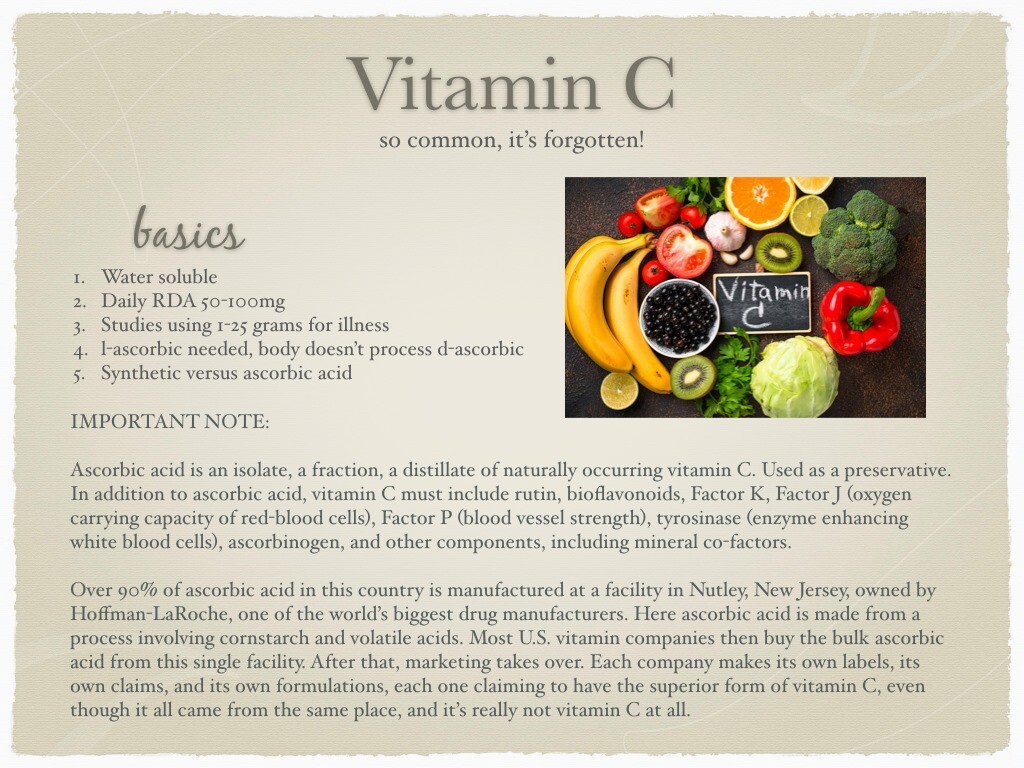
10. VITAMIN C
Water-soluble, with a low daily RDA guideline, this vitamin is super easy to get from daily food—it's everywhere! That being said, when asked where to get the best vitamin C, most people will answer, "oranges!" You can thank the MinuteMaid and Tropicana growers for that. Once again, it’s simply a fancy schmancy marketing campaign to get you to buy orange juice that has been "fortified" with vitamin C. Yes, oranges DO have vitamin C. But I bet you'd be surprised to learn veggies like broccoli, brussel sprouts, peppers, leafy greens, squash, and cauliflower are all high in vitamin C! Fruits like guava and strawberries are actually HIGHER in vitamin C than oranges.
Numerous studies and research have shown high doses of vitamin C to help the body weather illness and rebound in half the duration of of those without this important vitamin. Dosages between 1-25 grams have been used as supplements and even intravenously administered by doctors to combat illness.
So what happens if the body gets too much vitamin C? It is excreted in urine first. If there's simply too much, you'll have diarrhea. It is important to note that diarrhea is the body's course of action to dispose of toxins, dead viruses or bacteria, rapidly. It's why, when you're sick, have eaten something gone bad, or for women, have a menstrual cycle which floods the body with hormones, you often end up with diarrhea. A simple and effective tool for the body to expediently dispose of excess!
We do feel comfortable in our home taking large doses of vitamin C when sick. We've seen the effectiveness, the diminished severity, and the shortened duration of illness. We inundate ourselves with fruit and veggie smoothies, YL's Super C (two is about a gram!), and use pretty much everything I'm teaching about in this Dr. Mom class.
Here is one of the more recent studies seen on vitamin C and illness, but there are many more if you want to research!
Numerous studies and research have shown high doses of vitamin C to help the body weather illness and rebound in half the duration of of those without this important vitamin. Dosages between 1-25 grams have been used as supplements and even intravenously administered by doctors to combat illness.
So what happens if the body gets too much vitamin C? It is excreted in urine first. If there's simply too much, you'll have diarrhea. It is important to note that diarrhea is the body's course of action to dispose of toxins, dead viruses or bacteria, rapidly. It's why, when you're sick, have eaten something gone bad, or for women, have a menstrual cycle which floods the body with hormones, you often end up with diarrhea. A simple and effective tool for the body to expediently dispose of excess!
We do feel comfortable in our home taking large doses of vitamin C when sick. We've seen the effectiveness, the diminished severity, and the shortened duration of illness. We inundate ourselves with fruit and veggie smoothies, YL's Super C (two is about a gram!), and use pretty much everything I'm teaching about in this Dr. Mom class.
Here is one of the more recent studies seen on vitamin C and illness, but there are many more if you want to research!
Unfortunately, this vitamin is most often found as a synthetic. Most of the companies selling it actually derive their vitamin C from the largest source in the country and then create a proprietary blend of their own. See the graphic above for more information. SYNTHETIC: isolated vitamin from genetically modified corn sugar that is hydrogenated and processed with acetone.
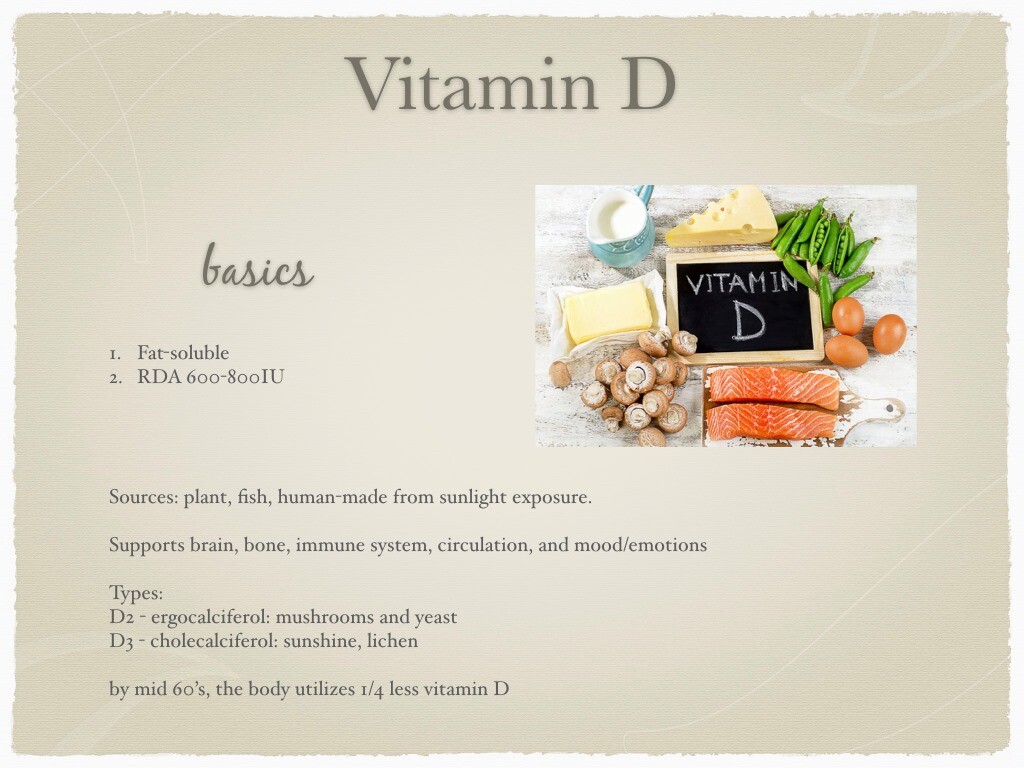
11. VITAMIN D
Fat-soluble, plant and fish derived, as well as human-made through exposure to sunlight, Vitamin D elps with mood, circulation, brain health, bone health, and immune system function. A daily dose of twenty minutes of sunshine will yield nearly all the vitamin D we need! We can also get it from lichen. This is vitamin D3 -cholecalciferol. The second D available is vitamin D2 - ergocalciferol, which is most often derived from irradiated mushrooms and yeast. Vitamin D can also be found in some types of fish, such as salmon, tuna, and mackerel.
Synthetic: To mimic the natural production found in skin, scientists irradiate animal fat to stimulate vitamin D3 synthesis. They usually use lanolin, the waxy secretions from sheep skin.
Synthetic: To mimic the natural production found in skin, scientists irradiate animal fat to stimulate vitamin D3 synthesis. They usually use lanolin, the waxy secretions from sheep skin.
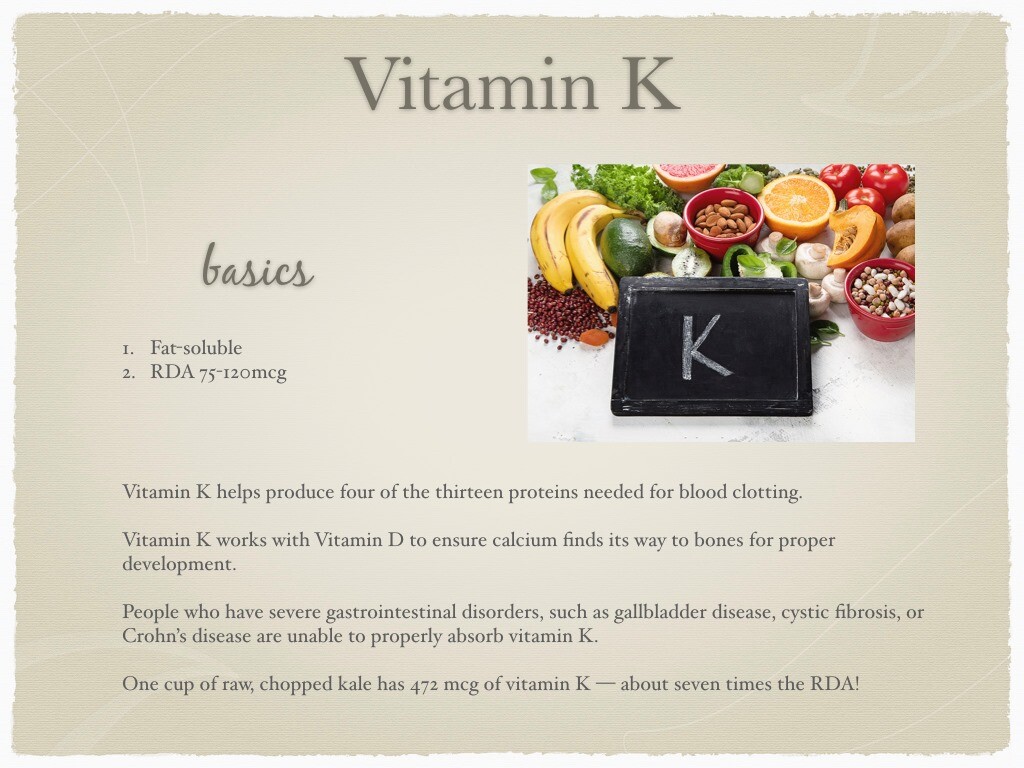
12. VITAMIN K
Vitamin K is important for proper blood clotting, some metabolic pathways, brain, heart, and bone health. It is found in dark leafy greens, veggies, and meat sources.
Synthetic: menadione; comes from coal tar derivatives and genetically modified and hydrogenated soybean oi; uses hydrochloric acid and nickel. It is considered highly toxic and damages the immune system.
Synthetic: menadione; comes from coal tar derivatives and genetically modified and hydrogenated soybean oi; uses hydrochloric acid and nickel. It is considered highly toxic and damages the immune system.
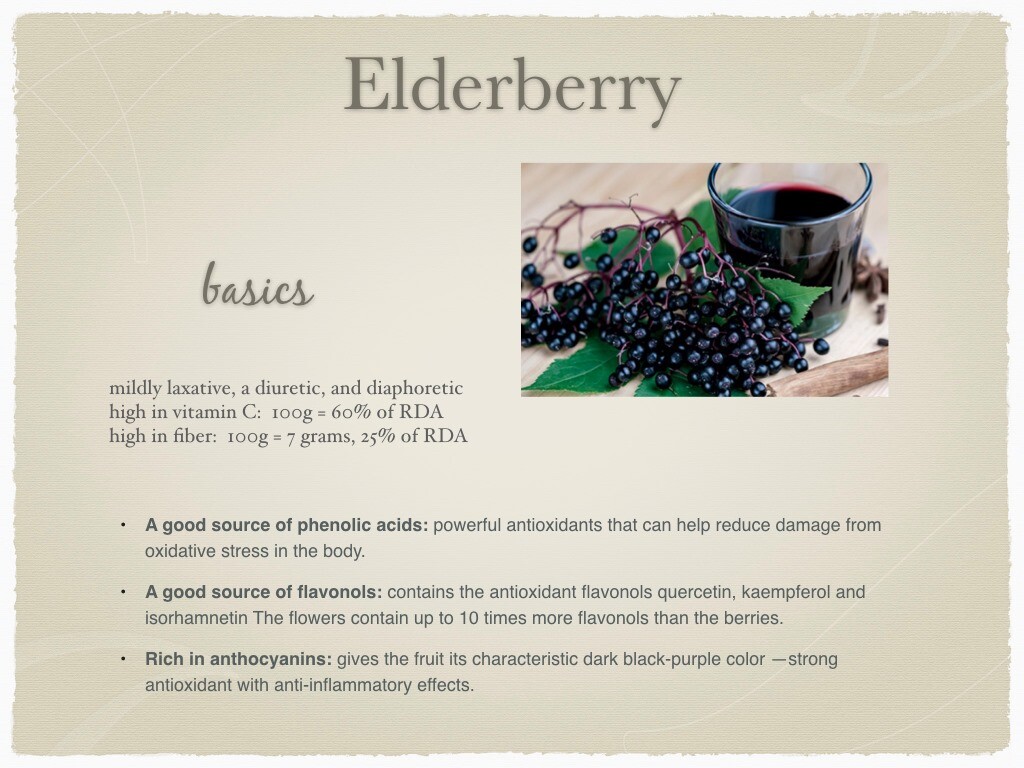
13. ELDERBERRY
A bunch has been written lately about elderberry and cytokine storms. Perhaps you've read something on this topic? I know there are a couple of blogs I've been asked about lately. The big question on minds: Do you need to worry about taking elderberry and creating a cytokine storm? The truth is some people have died from influenza and various other infections due to a "cytokine storm," but here's the thing. It is super crazy RARE and mostly a ton of unknown. We simply don't understand the exact pathophysiology of a cytokine storm. We do know, however, that it is not JUST an issue of immune system over-reaction, but also one of UNDER-REACTION.
The parts of the immune system responsible for creating inflammation are in hyperdrive, and the areas of the immune system that are supposed to regulate inflammation in the body and bring it back to homeostasis are simply not active enough. Remember, inflammation is not always bad. It's the normal systemic response of your body to injury, stress, infection, and even exercise. We need inflammation—it is part of the healing process. But when the body fails to regulate its inflammatory processes, things go haywire. A cytokine storm is the fight between PRO-inflamatory cytokines, ANTI-inflammatory cytokines, and REGULATORY cytokines. Adding to this is a lack of antioxidants and either under-utilized vitamins and glutathione or a lack thereof as well, which are essential to kill off all the free radicals that are created when we're sick.
So, back to that question: can elderberry possibly trigger a cytokine storm when you have influenza? Perhaps. Studies are constantly being done that reveal a deeper understanding of how our bodies work through sickness and the role our immune system functions play in healing. But…the history doesn't show it to be so. Centuries of effective and established elderberry use, data and research galore on its biological activity and efficacy against viruses and its immune and antioxidant protective properties are well established and documented.
Elderberry has been shown to increase BOTH PRO-inflammatory cytokines and ANTI-inflammatory cytokines, and REDUCE oxidative stress (oxidative stress = free radicals) and may, in fact, help to REGULATE inflammatory disease like autoimmunity. There have been no case reports of elderberry-induced cytokine storms. Elderberry as a supplement is one of dozens of products we can use to stay healthy and well. However, if you have any concerns, of course you should talk with your medical professional and do your own research!
Here is a video link of a panel of pharmacists discussing COVID-19. They discuss common sense measures for preventing infections, when to know if you need to be tested, nutrition for the immune system, and whether natural remedies like elderberry are helpful or harmful during this time. And here is one of many articles you can find on elderberry.
The parts of the immune system responsible for creating inflammation are in hyperdrive, and the areas of the immune system that are supposed to regulate inflammation in the body and bring it back to homeostasis are simply not active enough. Remember, inflammation is not always bad. It's the normal systemic response of your body to injury, stress, infection, and even exercise. We need inflammation—it is part of the healing process. But when the body fails to regulate its inflammatory processes, things go haywire. A cytokine storm is the fight between PRO-inflamatory cytokines, ANTI-inflammatory cytokines, and REGULATORY cytokines. Adding to this is a lack of antioxidants and either under-utilized vitamins and glutathione or a lack thereof as well, which are essential to kill off all the free radicals that are created when we're sick.
So, back to that question: can elderberry possibly trigger a cytokine storm when you have influenza? Perhaps. Studies are constantly being done that reveal a deeper understanding of how our bodies work through sickness and the role our immune system functions play in healing. But…the history doesn't show it to be so. Centuries of effective and established elderberry use, data and research galore on its biological activity and efficacy against viruses and its immune and antioxidant protective properties are well established and documented.
Elderberry has been shown to increase BOTH PRO-inflammatory cytokines and ANTI-inflammatory cytokines, and REDUCE oxidative stress (oxidative stress = free radicals) and may, in fact, help to REGULATE inflammatory disease like autoimmunity. There have been no case reports of elderberry-induced cytokine storms. Elderberry as a supplement is one of dozens of products we can use to stay healthy and well. However, if you have any concerns, of course you should talk with your medical professional and do your own research!
Here is a video link of a panel of pharmacists discussing COVID-19. They discuss common sense measures for preventing infections, when to know if you need to be tested, nutrition for the immune system, and whether natural remedies like elderberry are helpful or harmful during this time. And here is one of many articles you can find on elderberry.
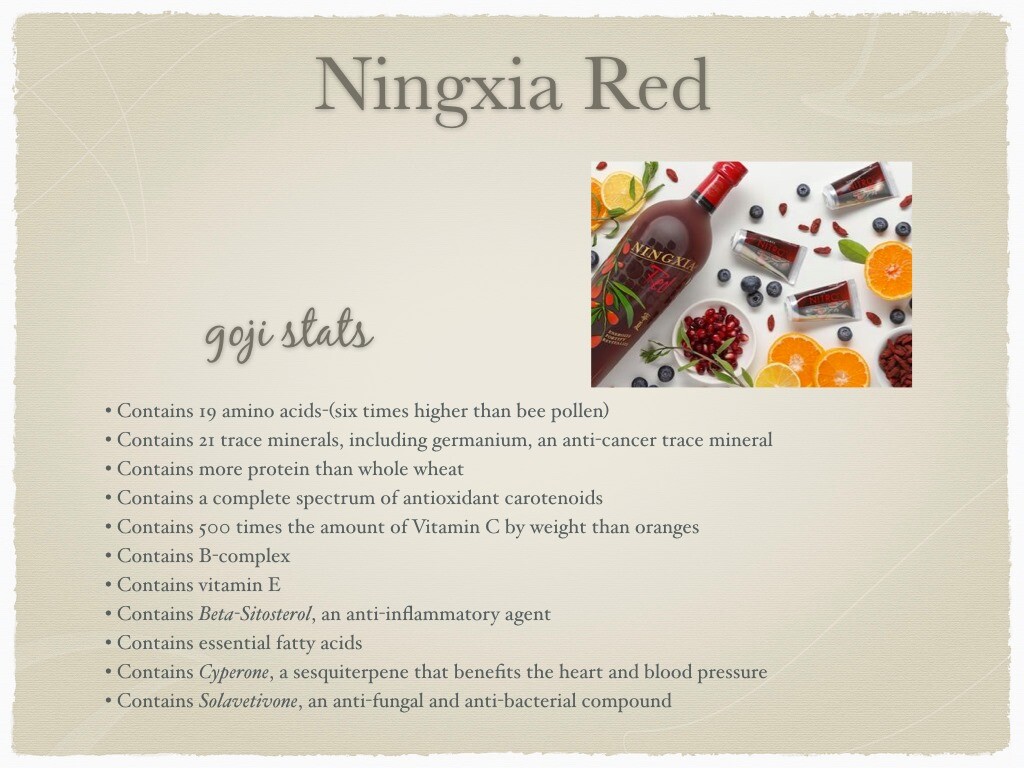
14. NINGXIA RED
This one is liquid gold in our home, a staple supplement we won't ever be without. I like to think of it as a "hole filler" in our standard American diet. See, most people have a diet that looks a bit like a piece of Swiss cheese: holes everywhere. Those are malnutrition holes. As much as we try to eat healthy, no one—I do repeat NO ONE—has the perfect diet, even those who are leaning hard into veggies and whole food sources. The content of vitamins and minerals in food changes from source to source due to environment, soil, enzymes added or present, and even the amount of sunlight or rain. Add to that eating in restaurants where you can only guess at origins and quality to food splurges at home, parties, and those times where you just forget what time it is and skip a meal.
Ningxia Red is our hole-filler! All the gaps filled with an ounce or two of this whole food puree liquid superhero in a bottle. Packed with protein, minerals and vitamins from some of the most nutrient dense fruits and berries on the planet—go research goji and aronia berry for a start!—and essential oils of tangerine, yuzu, and lemon. You absolutely won't find anything this good and pure in your local market.
There is SO MUCH I would love to tell you about this drink!! My kids call it "ninja juice" or "red juice," but all I know is, it's amazing. We are healthier than ever with this in our lives, and for me, with my family history of a few particularly scary health issues, I use NingXia as a preventative. Here is a link to a sway class with tons of great info on Ningxia Red. It's an older sway that will be updated to a more modern look soon, but the info is still super amazing! It's what convinced me and my husband to try it for a month back in 2016...and we've never looked back!
Ningxia Red is our hole-filler! All the gaps filled with an ounce or two of this whole food puree liquid superhero in a bottle. Packed with protein, minerals and vitamins from some of the most nutrient dense fruits and berries on the planet—go research goji and aronia berry for a start!—and essential oils of tangerine, yuzu, and lemon. You absolutely won't find anything this good and pure in your local market.
There is SO MUCH I would love to tell you about this drink!! My kids call it "ninja juice" or "red juice," but all I know is, it's amazing. We are healthier than ever with this in our lives, and for me, with my family history of a few particularly scary health issues, I use NingXia as a preventative. Here is a link to a sway class with tons of great info on Ningxia Red. It's an older sway that will be updated to a more modern look soon, but the info is still super amazing! It's what convinced me and my husband to try it for a month back in 2016...and we've never looked back!
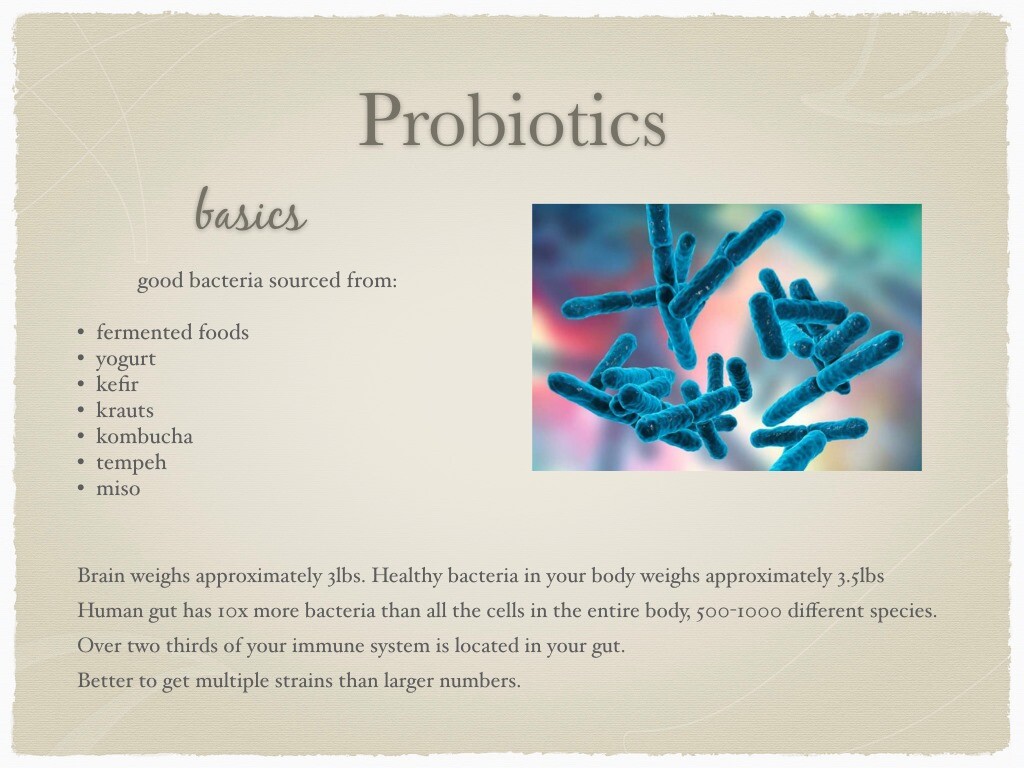
15. PROBIOTICS
Probiotics (Pro=For) (Biotic=Life): This is it, friends. The last highlight of our class, and perhaps the most important. In everything we do, we strive to keep our gut super healthy. It is your body's immune system core. The probiotic levels in your body determine all of your body's processes from mood and emotion, to digestion and elimination, all the way to rebuilding core structures. This is also one of the most understudied and unknown topics of the human body. Until recently, much of what we have discovered was simply not known to be of consequence, but over the last decade, we've been amazed to learn about this micro-universe living right inside of us, a micro-universe that quite literally has power of life or death.
Trillions. Over 100 trillion bacteria make your body a home. Science has discovered your gut, immune system, and brain are so tightly connected, they operate as one. Fail to take care of your gut, and a domino effect will happen throughout the body.
The big thing research is yielding: it isn't the volume of the strain you have, but rather the variety of strain that matters. For example, many people will grab a two strain probiotic number in the billions of cultures. The issue: there are literally hundreds of strains in the body. Don't make one king over everything, multiplying out of control. Plus, probiotics multiply so fast by multiplying from doubling their number in multiplication (2x2=4x4=16x16=256x256) so they are in the billions within half an hour.
Trillions. Over 100 trillion bacteria make your body a home. Science has discovered your gut, immune system, and brain are so tightly connected, they operate as one. Fail to take care of your gut, and a domino effect will happen throughout the body.
The big thing research is yielding: it isn't the volume of the strain you have, but rather the variety of strain that matters. For example, many people will grab a two strain probiotic number in the billions of cultures. The issue: there are literally hundreds of strains in the body. Don't make one king over everything, multiplying out of control. Plus, probiotics multiply so fast by multiplying from doubling their number in multiplication (2x2=4x4=16x16=256x256) so they are in the billions within half an hour.
Young Living has two probiotics. A capsule, Life 9 (nine strains) and MightyPro (a powdered pixie stick packet) for kids... or adults. One of the most phenomenal things about MightyPro is the prebiotic built right in. Those probiotics have to have something to eat to multiply! This technically makes our MightyPro a symbiotic rather than a straight probiotic. Our Life 9 was designed before research on prebiotics, but it is still one of the best supplements on the market with one of the largest variety of strains. Besides, you can get prebiotics from apples, onions, leeks, garlic, artichokes and a host of other common foods! NingXia Red is a great prebiotic as well!
Note: Remember, if you're taking antibiotics or products that kill off bacteria, you'll need to up your probiotic intake! I do this with our YL Inner Defense...because oregano. Oh, oregano. That one will destroy all the bacteria in high enough amounts. Needless to say, it's one of my absolute favorite essential oils!!!
I'm going to link two huge articles from the National Health Institute here, because I couldn't possibly type everything I want you to know. The 2020 article is more of a summary. The older article is lovely because it allows you to click on all the issues and disorders and open even more information.
That's it! You made it to the end! I'd love to hear what you learned and what you'd like to try in your own home!




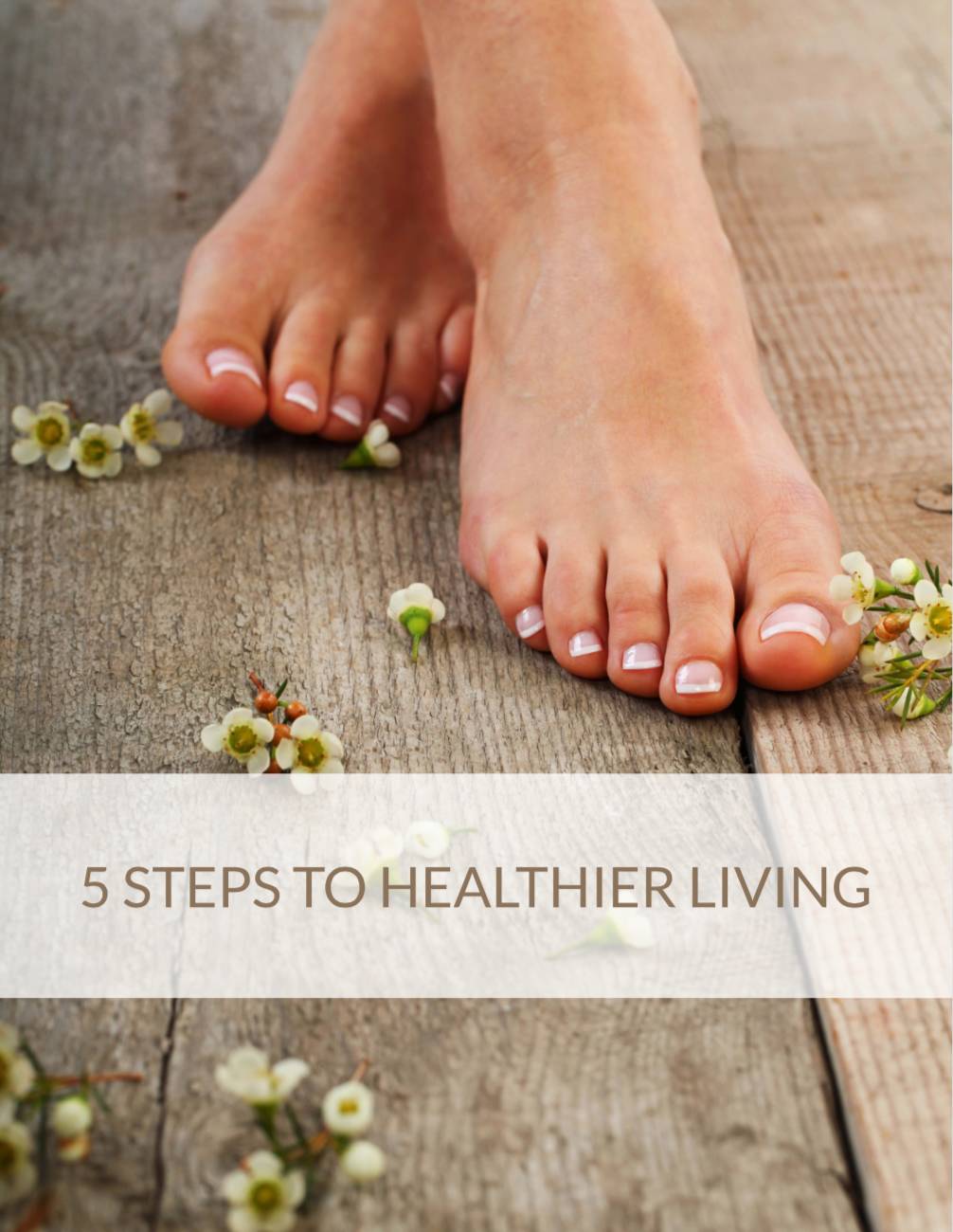 Free 5 Steps To Healthier Living Guide
Free 5 Steps To Healthier Living Guide



